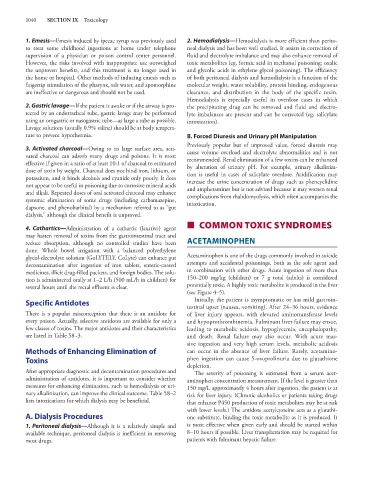Page 1054 - Basic _ Clinical Pharmacology ( PDFDrive )
P. 1054
1040 SECTION IX Toxicology
1. Emesis—Emesis induced by ipecac syrup was previously used 2. Hemodialysis—Hemodialysis is more efficient than perito-
to treat some childhood ingestions at home under telephone neal dialysis and has been well studied. It assists in correction of
supervision of a physician or poison control center personnel. fluid and electrolyte imbalance and may also enhance removal of
However, the risks involved with inappropriate use outweighed toxic metabolites (eg, formic acid in methanol poisoning; oxalic
the unproven benefits, and this treatment is no longer used in and glycolic acids in ethylene glycol poisoning). The efficiency
the home or hospital. Other methods of inducing emesis such as of both peritoneal dialysis and hemodialysis is a function of the
fingertip stimulation of the pharynx, salt water, and apomorphine molecular weight, water solubility, protein binding, endogenous
are ineffective or dangerous and should not be used. clearance, and distribution in the body of the specific toxin.
Hemodialysis is especially useful in overdose cases in which
2. Gastric lavage—If the patient is awake or if the airway is pro- the precipitating drug can be removed and fluid and electro-
tected by an endotracheal tube, gastric lavage may be performed lyte imbalances are present and can be corrected (eg, salicylate
using an orogastric or nasogastric tube—as large a tube as possible. intoxication).
Lavage solutions (usually 0.9% saline) should be at body tempera-
ture to prevent hypothermia. B. Forced Diuresis and Urinary pH Manipulation
Previously popular but of unproved value, forced diuresis may
3. Activated charcoal—Owing to its large surface area, acti- cause volume overload and electrolyte abnormalities and is not
vated charcoal can adsorb many drugs and poisons. It is most recommended. Renal elimination of a few toxins can be enhanced
effective if given in a ratio of at least 10:1 of charcoal to estimated by alteration of urinary pH. For example, urinary alkaliniza-
dose of toxin by weight. Charcoal does not bind iron, lithium, or tion is useful in cases of salicylate overdose. Acidification may
potassium, and it binds alcohols and cyanide only poorly. It does increase the urine concentration of drugs such as phencyclidine
not appear to be useful in poisoning due to corrosive mineral acids and amphetamines but is not advised because it may worsen renal
and alkali. Repeated doses of oral activated charcoal may enhance complications from rhabdomyolysis, which often accompanies the
systemic elimination of some drugs (including carbamazepine, intoxication.
dapsone, and phenobarbital) by a mechanism referred to as “gut
dialysis,” although the clinical benefit is unproved.
4. Cathartics—Administration of a cathartic (laxative) agent ■ COMMON TOXIC SYNDROMES
may hasten removal of toxins from the gastrointestinal tract and
reduce absorption, although no controlled studies have been ACETAMINOPHEN
done. Whole bowel irrigation with a balanced polyethylene
glycol-electrolyte solution (GoLYTELY, CoLyte) can enhance gut Acetaminophen is one of the drugs commonly involved in suicide
decontamination after ingestion of iron tablets, enteric-coated attempts and accidental poisonings, both as the sole agent and
medicines, illicit drug-filled packets, and foreign bodies. The solu- in combination with other drugs. Acute ingestion of more than
tion is administered orally at 1–2 L/h (500 mL/h in children) for 150–200 mg/kg (children) or 7 g total (adults) is considered
several hours until the rectal effluent is clear. potentially toxic. A highly toxic metabolite is produced in the liver
(see Figure 4–5).
Specific Antidotes Initially, the patient is asymptomatic or has mild gastroin-
testinal upset (nausea, vomiting). After 24–36 hours, evidence
There is a popular misconception that there is an antidote for of liver injury appears, with elevated aminotransferase levels
every poison. Actually, selective antidotes are available for only a and hypoprothrombinemia. Fulminant liver failure may ensue,
few classes of toxins. The major antidotes and their characteristics leading to metabolic acidosis, hypoglycemia, encephalopathy,
are listed in Table 58–3. and death. Renal failure may also occur. With acute mas-
sive ingestion and very high serum levels, metabolic acidosis
Methods of Enhancing Elimination of can occur in the absence of liver failure. Rarely, acetamino-
Toxins phen ingestion can cause 5-oxoprolinuria due to glutathione
depletion.
After appropriate diagnostic and decontamination procedures and The severity of poisoning is estimated from a serum acet-
administration of antidotes, it is important to consider whether aminophen concentration measurement. If the level is greater than
measures for enhancing elimination, such as hemodialysis or uri- 150 mg/L approximately 4 hours after ingestion, the patient is at
nary alkalinization, can improve the clinical outcome. Table 58–2 risk for liver injury. (Chronic alcoholics or patients taking drugs
lists intoxications for which dialysis may be beneficial. that enhance P450 production of toxic metabolites may be at risk
with lower levels.) The antidote acetylcysteine acts as a glutathi-
A. Dialysis Procedures one substitute, binding the toxic metabolite as it is produced. It
1. Peritoneal dialysis—Although it is a relatively simple and is most effective when given early and should be started within
available technique, peritoneal dialysis is inefficient in removing 8–10 hours if possible. Liver transplantation may be required for
most drugs. patients with fulminant hepatic failure.

